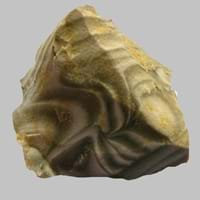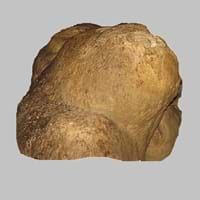Definition
Flint is a hard type of sedimentary rock that produces a small piece of burning material when hit by steel
Travertine is a mineral consisting of layered calcium carbonate formed by deposition from spring waters
Discoverer
Unknown
Marcus Vitruvius Pollio
Etymology
From Old English flint - a type of rock mainly known for high hardness and for giving off sparks when struck
From Italian travertino a kind of building stone, from Tiburs, adjective from Tibur (Tivoli), in Italy
Class
Sedimentary Rocks
Sedimentary Rocks
Sub-Class
Durable Rock, Hard Rock
Durable Rock, Medium Hardness Rock
Group
Not Applicable
Not Applicable
Other Categories
Fine Grained Rock, Opaque Rock
Fine Grained Rock, Opaque Rock
Texture
Banded, Rough
Banded
Color
Black, Brown, Green, Grey, Red, White
Beige, Black, Blue, Brown, Grey, Red, White, Yellow
Durability
Durable
Durable
Scratch Resistant
Yes
Yes
Appearance
Glassy or Pearly
Fibrous
Interior Uses
Decorative Aggregates, Homes, Interior Decoration
Decorative Aggregates, Entryways, Flooring, Homes, Interior Decoration
Exterior Uses
As Building Stone, As Facing Stone, Garden Decoration, Office Buildings, Paving Stone
As Building Stone, As Facing Stone, Paving Stone, Garden Decoration, Office Buildings
Other Architectural Uses
Curbing
Curbing
Construction Industry
Arrowheads, Cutting Tool, Spear Points
As Dimension Stone, Building houses or walls, Cement Manufacture, Construction Aggregate, for Road Aggregate, Raw material for the manufacture of mortar
Medical Industry
Not Yet Used
Not Yet Used
Antiquity Uses
Artifacts
Artifacts, Jewellery, Monuments, Sculpture, Small Figurines
Commercial Uses
Creating Artwork, Gemstone, In fire-starting tools, Manufacture of tools, Metallurgical Flux, Jewelry, To ignite fire, Used in flintlock firearms
Cemetery Markers, Creating Artwork, Gemstone, Jewelry, Paper Industry, Pottery
Types
Not Available
Not Available
Features
Clasts are smooth to touch, Easily splits into thin plates, Has High structural resistance against erosion and climate
Stalactites and stalagmites are formed from this rock, Surfaces are often shiny, Very fine grained rock
Archaeological Significance
Monuments
Not Yet Used
Used
Famous Monuments
Not Applicable
Colosseum in Rome, Italy, Sacré Coeur in Paris, France, Trevi Fountain in Rome, Italy
Sculpture
Not Yet Used
Used
Famous Sculptures
Not Applicable
Data Not Available
Pictographs
Not Used
Used
Petroglyphs
Not Used
Used
Figurines
Not Yet Used
Used
Formation
Flint is formed by the decomposition and compaction of various organisms such as sponges and diatoms under the water.
Travertine is a type of sedimentary rock formed when a river carries or transports pieces of broken rock which then undergo sedimentation. They are then subjected to high temperature and pressure hence forming travertine rock.
Mineral Content
Silicon
Calcite, Clay, Feldspar, Micas, Quartz
Compound Content
Silicon Dioxide
Ca, NaCl, CaO, Oxygen
Types of Metamorphism
Not Applicable
Not Applicable
Types of Weathering
Not Applicable
Biological Weathering, Chemical Weathering, Mechanical Weathering
Types of Erosion
Chemical Erosion, Coastal Erosion, Water Erosion
Chemical Erosion, Coastal Erosion, Glacier Erosion
Grain Size
Very fine-grained
Fine Grained
Fracture
Conchoidal
Splintery
Porosity
Highly Porous
Highly Porous
Luster
Vitreous
Dull to Pearly
Cleavage
Non-Existent
Non-Existent
Specific Gravity
2.5-2.8
1.68
Transparency
Translucent to Opaque
Opaque
Density
2.7-2.71 g/cm3
2.71 g/cm3
Resistance
Heat Resistant, Impact Resistant, Pressure Resistant, Wear Resistant
Impact Resistant, Pressure Resistant, Wear Resistant
Deposits in Eastern Continents
Asia
Azerbaijan, China, Russia
China, Russia
Africa
Not Yet Found
Not Yet Found
Europe
Austria, Belgium, Cyprus, Denmark, France, Germany, Italy, Malta, Netherlands, Poland, Portugal, Romania, Spain, Sweden, Switzerland, Turkey, Ukraine, United Kingdom
Austria, Italy, Portugal, United Kingdom
Others
Not Yet Found
Not Yet Found
Deposits in Western Continents
North America
USA
Canada, USA
South America
Bolivia
Argentina, Bolivia, Ecuador
Deposits in Oceania Continent
Australia
New Zealand, South Australia
Not Yet Found
All about Flint and Travertine Properties
Know all about Flint and Travertine properties here. All properties of rocks are important as they define the type of rock and its application. Flint and Travertine belong to Sedimentary Rocks.Texture of Flint is Banded, Rough whereas that of Travertine is Banded. Flint appears Glassy or Pearly and Travertine appears Fibrous. The luster of Flint is vitreous while that of Travertine is dull to pearly. Flint is available in black, brown, green, grey, red, white colors whereas Travertine is available in beige, black, blue, brown, grey, red, white, yellow colors. The commercial uses of Flint are creating artwork, gemstone, in fire-starting tools, manufacture of tools, metallurgical flux, jewelry, to ignite fire, used in flintlock firearms and that of Travertine are cemetery markers, creating artwork, gemstone, jewelry, paper industry, pottery.










